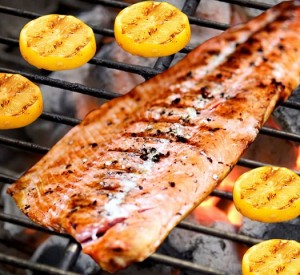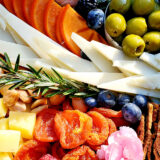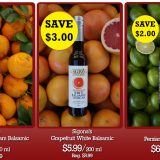Tips for Healthy Living: Sensational Salmon

Geri Wohl, CNC www.bettereatingcoach.com
Do you have a favorite type of salmon? Is it sockeye, king, coho or pink? Salmon, with its dense and flavorful flesh happens to be one of my personal favorite fish. Added to the flavor is the knowledge that it is good for our bodies and minds. The ancient Celts and Irish must have understood this, as salmon was associated with wisdom and knowledge in their mythology.
From the Pacific Ocean, we are often treated to wild salmon. Atlantic salmon, on the other hand, is usually farmed. Pacific salmon season runs from May through October with the peak off the west coast being late July. While you can get wild salmon throughout the year, if not purchased during the season, the fish will be frozen. Frozen fish is only good for up to four months. Salmon swim thousands of miles throughout their life cycles. They are born in fresh water, eventually migrate to the salty ocean and then travel upstream to their birth waters to spawn and die. Their typical life span is three to six years depending on the variety. Due to their long migrations in cold water and their long journey back to their spawning grounds, they have adapted to have the insulating layer of fat that is an important energy source for them and health benefit to us.
There are 6 main types of wild, pacific salmon although only five of them are fished.
- King or Chinook is thought to be the tastiest. King salmon is the largest and most expensive of the salmon types. It has very high fat content and rich meat due to this fat. It has one of the best omega 3:6 ratios of all the salmon types, benefiting our brains and heart.
- Sockeye or red salmon also has a deep rich flavor. Its bright red/orange flesh distinguishes it from other types of salmon. It is loaded with vitamin B12 that is important in blood cell formation, nervous system function and energy utilization.
- Coho or silver salmon have very silver skins. They have a milder flavor than king salmon because they contain less fat and fewer calories.
- Pink or humpback salmon is the most common type of Pacific salmon. It is light-colored and has a low fat content. It is typically canned or smoked and cheaper than other types of Pacific salmon.
- Chum, keta, silverbrite or dog salmon is smaller in size than other salmon. Chum also has a significantly lower fat content than king, sockeye or coho. It is usually found canned or frozen.
Atlantic salmon swim in the Atlantic Ocean as the name implies. Atlantic salmon are predominantly farm-raised meaning that the fish are grown in “controlled conditions” from the egg hatching phase through their growth culminating in their harvest. They are kept in pens and fed a controlled diet that promotes growth. There are many controversial issues concerning farm-raised salmon that are beyond the scope of this article. I would encourage you to learn more about the impact of farm-raised fish to make an informed choice.
Let’s delve into the health benefits of wild salmon and why I love to recommend it to my clients. Salmon is an excellent source of protein that is easy to digest. Salmon contains a complete array of amino acids, so the body can use these amino acid building blocks to make other cells, hormones, muscles and enzymes. The protein in salmon supports our cartilage and bones, regulates blood sugar by improving insulin effectiveness and reduces inflammation in the digestive tract.
 Salmon is also a wonderful source of omega 3 fatty acids. To read more about fats, see my article http://www.bettereatingcoach.com/7313-fearful-fats.html. As each cell needs healthy fats for its cell membranes, we can surmise why eating salmon promotes health throughout the body. Here are some of the effects of consuming omega 3 fatty acids. The omega 3s have been found to assist in lowering LDL cholesterol and raising HDL levels, resulting in improved cholesterol ratios. In addition, omega 3s are linked with lowering blood pressure and keeping our arteries from hardening. DHA, one of the omega 3s in salmon, is essential for brain development and brain health. Omega 3s also support our nervous system by improving memory in conjunction with vitamins A and D, certain amino acids and selenium. All salmon species contain substantial selenium, with king salmon having the highest amount. As anti-inflammatory compounds, omega 3s also help prevent blood clots and thus reduce the possibility of strokes. Omega 3 fatty acids are associated with improving hair, skin and eyes. See my article http://www.bettereatingcoach.com/81413-super-summertime-skin.html for more info about skin health. Omega 3s have been linked with helping to prevent macular degeneration. By consuming omega 3s in salmon, you may increase your metabolic rate, resulting in better blood sugar regulation. Lastly, a Swedish study of 6000 men over 30 years found that men who ate moderate amounts of fatty fish reduced their prostate cancer risk by 33%.
Salmon is also a wonderful source of omega 3 fatty acids. To read more about fats, see my article http://www.bettereatingcoach.com/7313-fearful-fats.html. As each cell needs healthy fats for its cell membranes, we can surmise why eating salmon promotes health throughout the body. Here are some of the effects of consuming omega 3 fatty acids. The omega 3s have been found to assist in lowering LDL cholesterol and raising HDL levels, resulting in improved cholesterol ratios. In addition, omega 3s are linked with lowering blood pressure and keeping our arteries from hardening. DHA, one of the omega 3s in salmon, is essential for brain development and brain health. Omega 3s also support our nervous system by improving memory in conjunction with vitamins A and D, certain amino acids and selenium. All salmon species contain substantial selenium, with king salmon having the highest amount. As anti-inflammatory compounds, omega 3s also help prevent blood clots and thus reduce the possibility of strokes. Omega 3 fatty acids are associated with improving hair, skin and eyes. See my article http://www.bettereatingcoach.com/81413-super-summertime-skin.html for more info about skin health. Omega 3s have been linked with helping to prevent macular degeneration. By consuming omega 3s in salmon, you may increase your metabolic rate, resulting in better blood sugar regulation. Lastly, a Swedish study of 6000 men over 30 years found that men who ate moderate amounts of fatty fish reduced their prostate cancer risk by 33%.
Other important nutrients in salmon include the B vitamins, particularly niacin, B6 and B12. B vitamins play an essential role as an energy source throughout the body. In addition, king salmon is a good source of the mineral magnesium. Magnesium is needed as a co-factor in over 300 enzyme reactions throughout the body. As mentioned above, salmon contains a rich supply of selenium, an important antioxidant to neutralize free radicals.
Salmon is highly perishable so make sure it stays cold and use it quickly. Salmon should be prepared in ways that will keep it moist and tender. Avoid overcooking salmon, as it will lose flavor and be tasteless. The best salmon preparations are baked, broiled or grilled. For a delicious salmon recipe, see my site http://www.bettereatingcoach.com/recipe-winter-2011.html. While we don’t need to be so concerned about mercury in salmon, the skin of salmon is the most vulnerable to pollution. It may be best to remove the skin before eating. As salmon has been consumed for thousands of years, enjoy this treasure of the sea and reap the rewards.
© Geri Wohl, CNC










